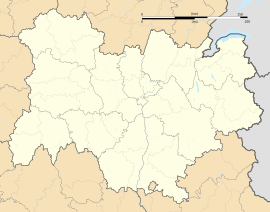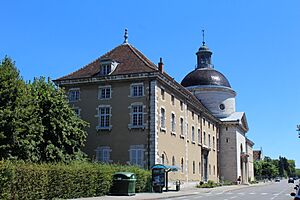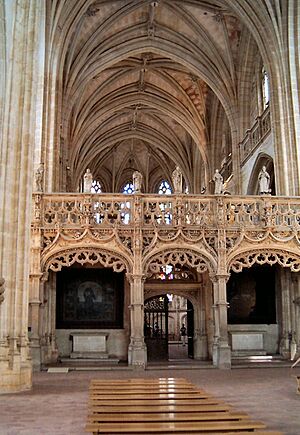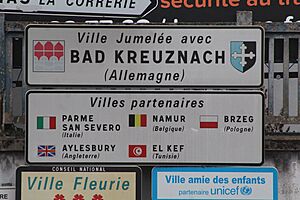Bourg-en-Bresse facts for kids
Quick facts for kids
Bourg-en-Bresse
Bôrg (Arpitan)
|
|||
|---|---|---|---|
|
Prefecture and commune
|
|||
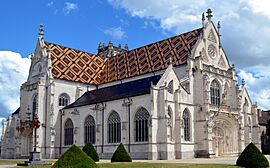
A view of the Church of Saint-Nicolas-de-Tolentin at the Royal Monastery of Brou
|
|||
|
|||
| Country | France | ||
| Region | Auvergne-Rhône-Alpes | ||
| Department | Ain | ||
| Arrondissement | Bourg-en-Bresse | ||
| Canton | Bourg-en-Bresse-1 and 2 | ||
| Intercommunality | CA Bassin de Bourg-en-Bresse | ||
| Area
1
|
23.99 km2 (9.26 sq mi) | ||
| Population
(2021)
|
41,525 | ||
| • Density | 1,730.9/km2 (4,483.1/sq mi) | ||
| Demonym(s) | Burgiens | ||
| Time zone | UTC+01:00 (CET) | ||
| • Summer (DST) | UTC+02:00 (CEST) | ||
| INSEE/Postal code |
01053 /01000
|
||
| Elevation | 220–273 m (722–896 ft) (avg. 240 m or 790 ft) |
||
| 1 French Land Register data, which excludes lakes, ponds, glaciers > 1 km2 (0.386 sq mi or 247 acres) and river estuaries. | |||
Bourg-en-Bresse is a city in eastern France. It's the main city of the Ain department in the Auvergne-Rhône-Alpes region. You can find it about 70 kilometers (43 miles) northeast of Lyon. Bourg-en-Bresse is also known as the capital of the old province of Bresse. In 2018, about 41,248 people lived there.
Contents
Geography
Bourg-en-Bresse is located at the western edge of the Jura Mountains. It sits on the left bank of the Reyssouze River, which flows into the Saône river. The city is about 70 kilometers (43 miles) northeast of Lyon and 50 kilometers (31 miles) south-southwest of Lons-le-Saunier.
History
People have found old Roman remains in Bourg-en-Bresse, but we don't know much about its very early days. It was probably attacked by the Goths a long time ago.
In 1250, Bourg-en-Bresse became a "free town," meaning it had more control over itself. In the early 15th century, it was the capital for the dukes of Savoy in the Bresse region.
In 1535, France took control of the city, but it was given back to Duke Philibert Emmanuel in 1559. He married Henri II's sister, Marguerite. The duke later built a strong fort. This fort was so strong that it held out for six months against the soldiers of Henry IV during a war in 1600–1601. Finally, in 1601, the town officially became part of France.
In 1814, even though the city couldn't really defend itself, the people of Bourg-en-Bresse tried to fight against the Austrians. Because of this, the Austrians attacked and robbed the town.
Cool Places to See
The main church in Bourg-en-Bresse is called Bourg-en-Bresse Cathedral, or Notre-Dame. It was built in the 16th century. The front of the church looks like Renaissance style, while other parts are Gothic. Inside, you can see old wooden seats from the 16th century.
Other important buildings in the town are quite modern, like the prefecture (a government building). The town hall has a library and the Lorin Museum, which displays paintings. Another museum shows old clothes and jewelry from the Bresse area. You can also find statues in the town, including one of the historian Edgar Quinet, who was born here.
The Royal Monastery of Brou is a very special place for art. It's located in a part of Bourg-en-Bresse. Margaret of Bourbon wanted to build a monastery here, but she passed away before it could happen. Her daughter-in-law, Margaret of Austria, built the church in the early 16th century to remember her husband, Philibert le Beau.
The outside of the monastery, especially the front, is very detailed. But the real treasures are inside, with artworks from 1532. The most important are three tombs with marble statues of Marguerite of Bourbon, Philibert le Beau, and Margaret of Austria. These statues are famous for their perfect carving and rich decorations. The wooden screen, the oak seats, and the altar in the Virgin Mary's chapel are also amazing artworks. The monastery has three courtyards from the early 16th century. Both the church and the courtyards are protected as historical monuments.
Economy
In the early 1900s, Bourg-en-Bresse made things like iron goods, mineral water, soap, and pottery. There were also places that made flour and brewed beer. The city was a busy center for trading grain, cattle, and poultry.
Transport
Bourg-en-Bresse station is the train station. You can take high-speed trains from here to cities like Paris, Strasbourg, Lyon, and Geneva. There are also regional train services. Major highways like the A39 connect Bourg-en-Bresse to Dole and Dijon. The A40 highway connects it to Mâcon and Geneva.
Sport
The city is home to the football team Football Bourg-en-Bresse Péronnas 01. In 1953, a motorcycle race was held on a track that went past some local landmarks.
Other Facts
Bourg-en-Bresse is the main city of its department. It has important courts and a local branch of the Bank of France.
The city was also a finish line for Stage 6 and the starting point for Stage 7 of the 2007 Tour de France bicycle race.
Famous People
Many notable people were born in Bourg-en-Bresse:
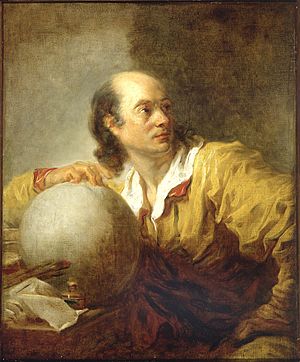
- Claude Gaspard Bachet de Méziriac (1581–1638), a mathematician.
- Julien Benneteau (born 1981), a tennis player.
- Georges Blanc (born 1943), a famous chef.
- Raymond Chevallier (1929–2004), a historian and archaeologist.
- François Clerc (born 1983), a footballer who played for Olympique Lyonnais and the French national team.
- Alain Giletti (born 1939), an ice skater.
- Jérôme Lalande (1732–1807), an astronomer and writer.
- Isabelle Lonvis-Rome (born 1963), a judge and government minister.
- Daniel Morelon (born 1944), a cyclist.
- Jean-Bernard Gauthier de Murnan (1748–1796), a French officer who fought in the Continental Army and was a general during the French Revolution.
- Lionel Nallet (born 1976), an international rugby union player.
- Jacques Pépin (born 1935), another famous chef.
- Edgar Quinet (1803–1875), a historian and writer.
- Jérôme Tafani (born 1958), a businessman.
Sister Cities
Bourg-en-Bresse has special connections with other cities around the world, called "twin towns" or "sister cities." This helps people from different countries learn about each other.
 Bad Kreuznach, Germany
Bad Kreuznach, Germany Aylesbury, England
Aylesbury, England San Severo, Italy
San Severo, Italy Parma, Italy
Parma, Italy Namur, Belgium
Namur, Belgium Brzeg, Poland
Brzeg, Poland El Kef, Tunisia
El Kef, Tunisia
Images for kids
See also
 In Spanish: Bourg-en-Bresse para niños
In Spanish: Bourg-en-Bresse para niños





